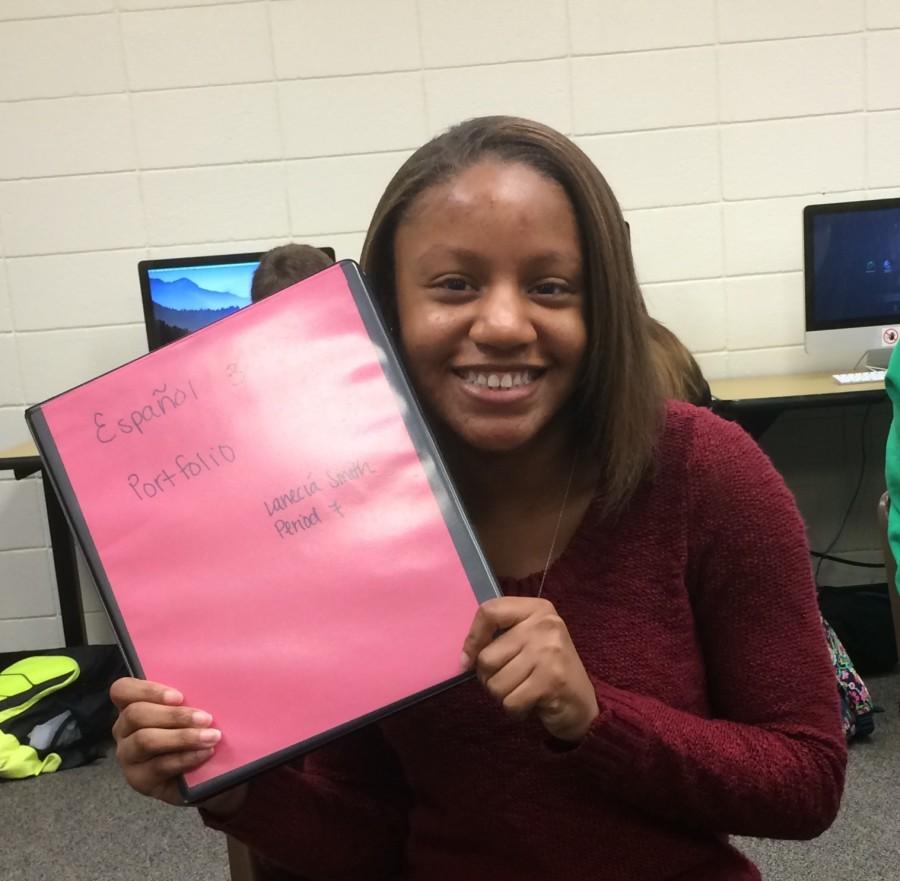Foreign Language Exams Leave Students Tongue-Tied
When the Testing Methods are Just as Foreign as the Languages
Junior Lanecia Smith holds her portfolio: A binder full of “evidence.”
January 15, 2015
Students studying foreign languages are not cramming and going through notes for exams this year, but instead they’re tackling something totally different. This school year foreign language students must provide a portfolio full of such things as essays, projects, video clips, and audio recordings to prove that they are at the level of proficiency they are required to meet. This level varies, and is dependent on the individual and their class. The grade on this portfolio will be the midterm grade.
This change in testing methods has occurred because foreign language teachers find it more productive to challenge students to prove their proficiency than to give them a lengthy traditional test.
“In foreign languages, it’s hard to test what a student has learned and how they speak in a test or just through short answer. It’s a better judge of what they actually know,” said Spanish teacher Ms. Erin Hunkemoeller.
Some students are loving being able to keep physical records of their improvements.
“I like the fact that I can see my progress and compare my Spanish from first quarter to now,” said junior Sarah Avdakov.
Others simply enjoy creating portfolios more than they do taking a test.
“[I like] The whole not taking a test for an hour,” said sophomore Malcolm Amin.
The reason of the test also seems clearer.
“I understand the purpose and it’s better than exams,” said sophomore Kara Brown.
The teachers are under the impression the students like them better as well.
“The students have seemed to like them better,” said Hunkemoeller. “They like the option to be able to speak or show us what they can do more than just cramming for a test.”
However, there are students who would prefer to take a test, some arguing that proficiency is tested the conventional way.
“I’m not too big on the portfolio. I’d rather take the traditional test,” said junior Jordan Thomas.
The time the portfolios require to assemble is a concern amongst students as well.
“The same knowledge, in my opinion, could be shown in a test, except for the interpersonal communication,” said junior John Bates. “I definitely would (rather take the traditional test). That’s one to two nights of study and a period of testing compared to multiple periods and nights spent on portfolios.”
Along with being time-consuming, students also find the portfolios difficult.
“It was really unorganized, hard to work on the iPad, and took a bit of time,” said Brown.
Students have brainstormed many ways to make the portfolio process better.
“Have teachers find better ways to include learning targets in their daily lessons, such as doing a discussion with new vocabulary as part of interpersonal communication, or applying the targets to projects that we will do anyway,” said Bates.
Targets have created much discussion amongst students.
“We need to work on more than just one target. I have a lot of assignments that only meet one requirement, and so only one is useful for the portfolio,” said junior Riley Jenkins.
The portfolios have proven to be effective in testing for language proficiency.
“We’ve gotten some really good results so far on the one’s that weve graded. And they seem to be more accurate, too,” said Hunkemoeller.
Regardless of mixed opinions, the foreign language portfolios are here to stay. The final exam will include building onto these portfolios to prove growth.



